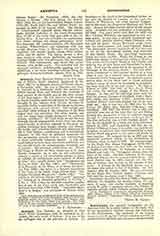

Armentia, FRAY NICOLAS, Bishop of La Paz (capital of Bolivia, South America), appointed October 22, 1901; b. at Bemedo, diocese of Vittoria, Spain, December 5, 1845. He was a Minorite and came to America as a missionary under the guidance of Father Rafael Sans, and followed the footsteps of that pioneer in the forests and on the river courses of the Beni region. He had, previous to his coming to South America, spent several years in France, and brought to the mission field, besides devotion to apostolic duties, a solid fund of knowledge in physics, astronomy, and natural science. The savage and cannibal tribes lurking in the fastnesses of the Beni region were not numerous, but often hostile, and had for years been cruelly decimated by epidemic disease (smallpox). To reach them he cut his way through almost impenetrable woods from one abandoned hamlet to another, exposed to the most appalling hardships from hunger, climate, and disease. He taught and preached wherever and whenever he fell in with Indians, establishing and reestablishing missions; in this way he gathered materials for the geography, natural history, and anthropology of those practically unknown regions. It cost him much labor to have these afterwards published, and his valuable books are, unfortunately, extremely rare at present. His principal publications are: “Diario del Viage al Madre de Dios, hecho por el P. Fray Nicolas Armentia, en el aiio de mil ochocientos ochenta y cuatro y mil ochocientos ochenta y cinco, en calidad de comisionado para explorar el Madre de Dios” etc.; usually bound with “Navegacibn del Madre de Dios” (La Paz, 1887); and “Description de la Provincia de los Mojos, en el Reino del Peru” (La Paz, 1888)—the latter is a Spanish translation of the book of the Jesuit Franz Xavier Eder, “Descriptio Provinciee Moxitarum” (Buda, 1791). “Vocabulario del Idioma Shipibo del Ucayali” appeared in “Boletin de la Sociedad geografica de La Paz”, I, No. 1. This is thus far the most complete vocabulary of any of the Pano stock (see Arawaks), and embraces more than 3,800 words. “Los Indios Mosetenes y su lengua” was published at Buenos Aires, 1903.
AD. F. BANDELIER

